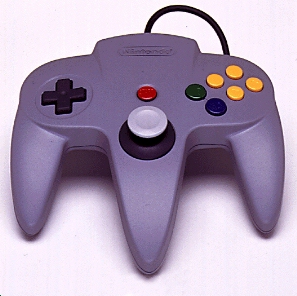
THE NINTENDO 64 SYSTEM
This part of my page is dedicated to the Nintendo 64 Hardware. I
have tried my best to find the the most information I could about the system. So, continue forth and bring you knowledge about this great system to a higher level.
So, continue forth and bring you knowledge about this great system to a higher level.
Choose what you want to learn about and the information will appear.
The System
The Controller
The Cartridges

OFFICIAL TECHNICAL SPECIFICATIONS
THE CENTRAL PROCESSOR UNIT
A MIPS 64bit RISC at 93.75 Mhz (Customized R4300 Series)
MEMORY TYPE
Rambus 36 MBits of 9-bit DRAM with a maximum transfer speed of 4,500 MBits per second
CO-PROCESSOR
Reality Co-processor which includes a built in sound processor, graphics processor, and pixel
drawing processor running at 62.5 Mhz
RESOLUTION
256 by 224 to 640 by 480 dots with flicker free interlace mode support
COLOR
32-bit RGBA pixel color frame buffer support, 21-bit color video output
COOL FEATURES
Anti-aliasing which smoothes out jagged edges
Microcode-Custom CPU control instructinons optimized for audio, lighting, graphic details and other ultra-realistic affects
Texture Mapping-Puts a bitmap picture, or texture onto a surface
Trilinear MIP-map interpolation-Subtly blends colors and patterns of texture mapsto make objects more realistic, even as they move closer to you
Z-Buffer-Keeps stuff in the right place even if your moving quickly. Objects maintain their true spatial relationships
VIDEO OUTPUT
Standard RF Output (like previous systems)
Stereo Audio/Visual Jack
S-Video
High Definition Television Compatable
AUDIO
Unlimited Chanels (though limited because each channel uses 1% of the CPU's power)
16-bit stereo sound quality
ADPCM compression
Wavetable synthesis quality music
Quality of sound- Cd quality (44.1 Khz)
ADD-ON CAPABILITIES
Add on port on underside of system for the 64DD
Cartridge port supports add-ons
Controller ports support add-ons(hmm...8 player?)
Memory Expansion slot on the top of the system for the add-on ram to come with the 64DD
A MODEM JACK which is located at the back of the system
Return to the System Parts List

Specifications
The controller has 3 grip sticks
Center Stick has an analogue stick, which is sensitive to the nearest 1 degree
The center stick also contains a Start button located above the analogue stick
Left stick has the old failthful D-Pad
Right stick has 6 buttons, all the buttons can be used to control character action but the 4 yellow C
buttons are mainly for controlling camera angles
The L and R buttons are again located at the top of the control pad
At the rear of the controller an interchangeable cartridge slot is located- the cartridges can hold up to 2MB
The middle stick also has a button on the back of it, called the Z button
Return to the System Parts List
Specifications
Storage Format
ROM cartridges that use JPEG compression
The games will be compressed to fit on cartridges starting at 64 Mbits up to 96Mbits
Compare the 64 Mbit to 96 Mbit cartridges to SNES cartridges that maxed out at 32 Mbits
Return to the System Parts List

 So, continue forth and bring you knowledge about this great system to a higher level.
So, continue forth and bring you knowledge about this great system to a higher level.

 So, continue forth and bring you knowledge about this great system to a higher level.
So, continue forth and bring you knowledge about this great system to a higher level.


